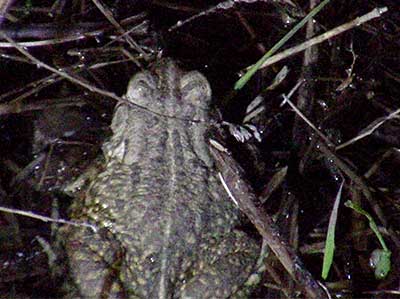

Amphibians like the Fowler' toad pictured above use the storm water runoff area as a breeding ground. But silt buildup could make the area unfriendly for mating activity.
Project: North Burial Grounds Amphibian Habitat
Location: Providence Map It
Description:
The Green Infrastructure Coalition is interested in including creation of amphibian habitat in the standard manual of practices for increasing resilience in our communities. Friends of the Moshassuck is pushing the envelope.
Beyond simply preventing flooding and reducing pollution in our waters, we need to find beneficial ways to use our cleaner storm water. One such use could be as breeding habitat for amphibians such as frogs, toads, and salamanders. Amphibians are a bellwether for healthy communities because they are sensitive to environmental degradation and need a variety of habitats to insure their survival.
In the North Burial Ground, runoff from 3 roads ends up in a depression that can hold water for a week or 4 months, depending upon how much it rains. Fowler’s Toads and Gray Tree Frogs breed there. But due to silt from upstream, the area is filling in fast and characteristics are changing. Too much buildup will prevent it from holding water long enough for metamorphosis to take place.
Routine maintenance to prevent silting has never been done, but Greg Gerritt is engaged in discussions with the various authorities about taking action. There are other places in Rhode Island and beyond which might be able to use storm water to aid amphibians, and therefore we need to think carefully about regulations and see if they can be a bit more amphibian friendly.
Friends of the Moshassuck is partnering with the City of Providence on this. To explain and clearly demonstrate how the rainwater pool functions and what lives there, Gerritt is producing a series of short (2 to 5 minutes) videos that show the ups and downs of the pool for each month of a year. One of the purposes of the video series is to have evidence available so that RIDEM can decide what is proper at the site, and then document the work we do to keep amphibians hopping in Providence.